Enterprise Resource Planning (ERP) Systems and Quality Factors Review
VerifiedAdded on 2022/08/18
|26
|12802
|17
Literature Review
AI Summary
This literature review explores Enterprise Resource Planning (ERP) systems, examining their quality factors to improve employee productivity and gain a competitive advantage. The study focuses on system quality (SQ), information quality (IQ), and service quality (SRQ), highlighting exemplary measures used to evaluate ERP systems. The review provides insights into the impact of these quality factors, offering recommendations for future research. It summarizes current empirical work on each quality factor and discusses the benefits ERP systems bring to organizations, such as increased productivity, improved information access, enhanced workflow, and automation of business processes. The paper also includes a table summarizing key ERP concepts from various authors and concludes with a discussion of the importance of these factors in the context of Information System (IS) success, as defined by Delone and McLean's IS success model.
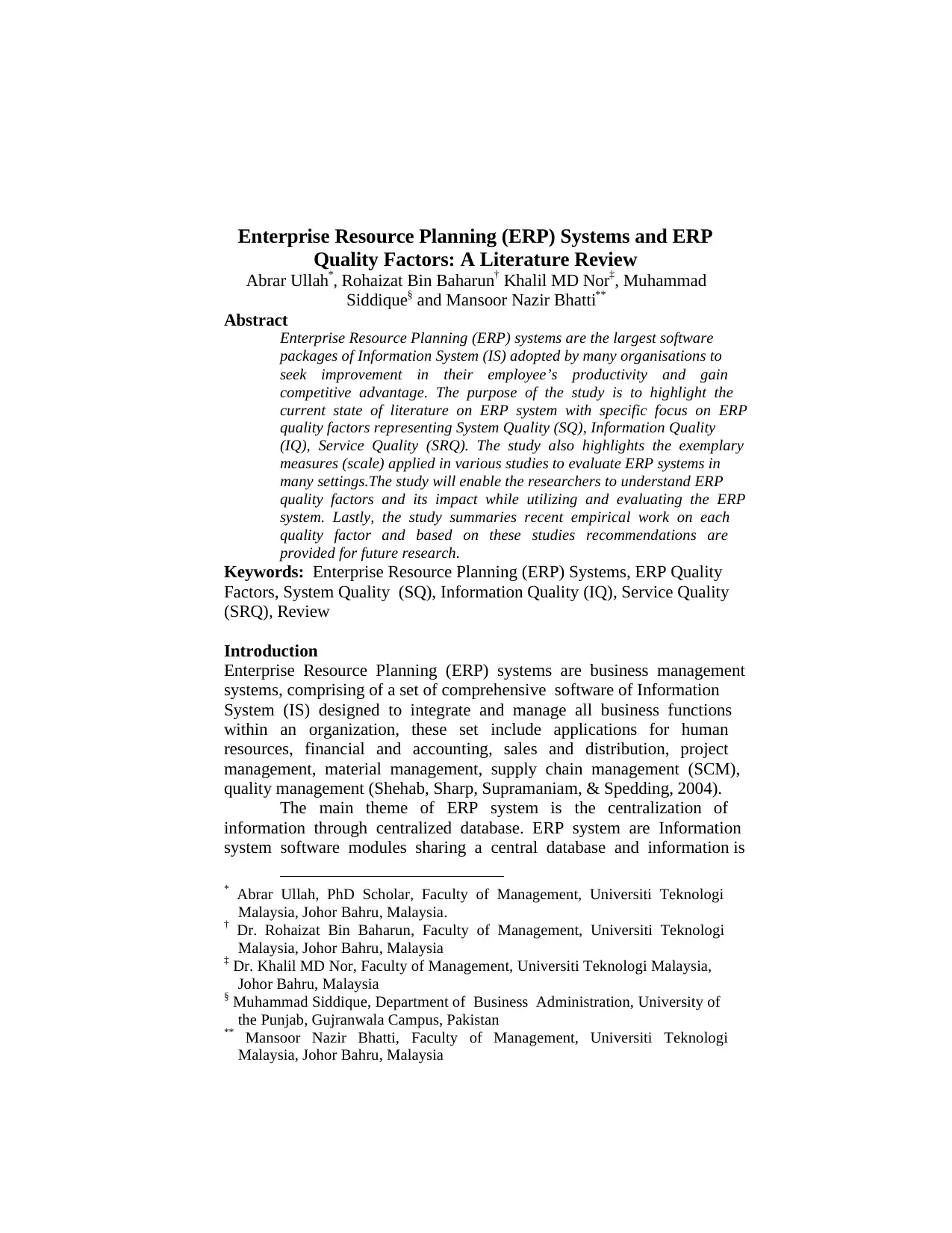
Enterprise Resource Planning (ERP) Systems and ERP
Quality Factors: A Literature Review
Abrar Ullah*, Rohaizat Bin Baharun† Khalil MD Nor‡, Muhammad
Siddique§ and Mansoor Nazir Bhatti**
Abstract
Enterprise Resource Planning (ERP) systems are the largest software
packages of Information System (IS) adopted by many organisations to
seek improvement in their employee’s productivity and gain
competitive advantage. The purpose of the study is to highlight the
current state of literature on ERP system with specific focus on ERP
quality factors representing System Quality (SQ), Information Quality
(IQ), Service Quality (SRQ). The study also highlights the exemplary
measures (scale) applied in various studies to evaluate ERP systems in
many settings.The study will enable the researchers to understand ERP
quality factors and its impact while utilizing and evaluating the ERP
system. Lastly, the study summaries recent empirical work on each
quality factor and based on these studies recommendations are
provided for future research.
Keywords: Enterprise Resource Planning (ERP) Systems, ERP Quality
Factors, System Quality (SQ), Information Quality (IQ), Service Quality
(SRQ), Review
Introduction
Enterprise Resource Planning (ERP) systems are business management
systems, comprising of a set of comprehensive software of Information
System (IS) designed to integrate and manage all business functions
within an organization, these set include applications for human
resources, financial and accounting, sales and distribution, project
management, material management, supply chain management (SCM),
quality management (Shehab, Sharp, Supramaniam, & Spedding, 2004).
The main theme of ERP system is the centralization of
information through centralized database. ERP system are Information
system software modules sharing a central database and information is
* Abrar Ullah, PhD Scholar, Faculty of Management, Universiti Teknologi
Malaysia, Johor Bahru, Malaysia.
† Dr. Rohaizat Bin Baharun, Faculty of Management, Universiti Teknologi
Malaysia, Johor Bahru, Malaysia
‡ Dr. Khalil MD Nor, Faculty of Management, Universiti Teknologi Malaysia,
Johor Bahru, Malaysia
§ Muhammad Siddique, Department of Business Administration, University of
the Punjab, Gujranwala Campus, Pakistan
** Mansoor Nazir Bhatti, Faculty of Management, Universiti Teknologi
Malaysia, Johor Bahru, Malaysia
Quality Factors: A Literature Review
Abrar Ullah*, Rohaizat Bin Baharun† Khalil MD Nor‡, Muhammad
Siddique§ and Mansoor Nazir Bhatti**
Abstract
Enterprise Resource Planning (ERP) systems are the largest software
packages of Information System (IS) adopted by many organisations to
seek improvement in their employee’s productivity and gain
competitive advantage. The purpose of the study is to highlight the
current state of literature on ERP system with specific focus on ERP
quality factors representing System Quality (SQ), Information Quality
(IQ), Service Quality (SRQ). The study also highlights the exemplary
measures (scale) applied in various studies to evaluate ERP systems in
many settings.The study will enable the researchers to understand ERP
quality factors and its impact while utilizing and evaluating the ERP
system. Lastly, the study summaries recent empirical work on each
quality factor and based on these studies recommendations are
provided for future research.
Keywords: Enterprise Resource Planning (ERP) Systems, ERP Quality
Factors, System Quality (SQ), Information Quality (IQ), Service Quality
(SRQ), Review
Introduction
Enterprise Resource Planning (ERP) systems are business management
systems, comprising of a set of comprehensive software of Information
System (IS) designed to integrate and manage all business functions
within an organization, these set include applications for human
resources, financial and accounting, sales and distribution, project
management, material management, supply chain management (SCM),
quality management (Shehab, Sharp, Supramaniam, & Spedding, 2004).
The main theme of ERP system is the centralization of
information through centralized database. ERP system are Information
system software modules sharing a central database and information is
* Abrar Ullah, PhD Scholar, Faculty of Management, Universiti Teknologi
Malaysia, Johor Bahru, Malaysia.
† Dr. Rohaizat Bin Baharun, Faculty of Management, Universiti Teknologi
Malaysia, Johor Bahru, Malaysia
‡ Dr. Khalil MD Nor, Faculty of Management, Universiti Teknologi Malaysia,
Johor Bahru, Malaysia
§ Muhammad Siddique, Department of Business Administration, University of
the Punjab, Gujranwala Campus, Pakistan
** Mansoor Nazir Bhatti, Faculty of Management, Universiti Teknologi
Malaysia, Johor Bahru, Malaysia
Paraphrase This Document
Need a fresh take? Get an instant paraphrase of this document with our AI Paraphraser
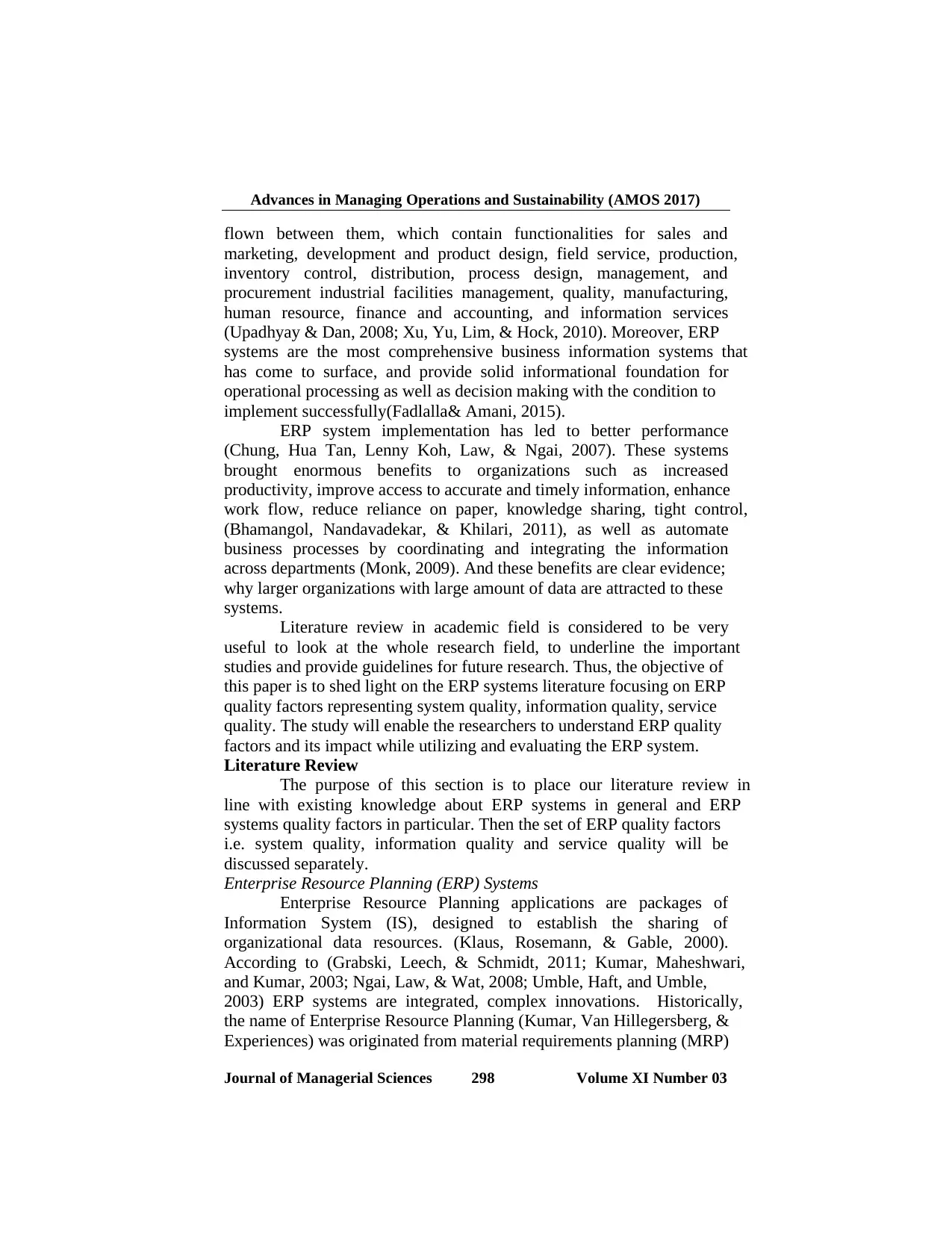
Advances in Managing Operations and Sustainability (AMOS 2017)
Journal of Managerial Sciences 298 Volume XI Number 03
flown between them, which contain functionalities for sales and
marketing, development and product design, field service, production,
inventory control, distribution, process design, management, and
procurement industrial facilities management, quality, manufacturing,
human resource, finance and accounting, and information services
(Upadhyay & Dan, 2008; Xu, Yu, Lim, & Hock, 2010). Moreover, ERP
systems are the most comprehensive business information systems that
has come to surface, and provide solid informational foundation for
operational processing as well as decision making with the condition to
implement successfully(Fadlalla& Amani, 2015).
ERP system implementation has led to better performance
(Chung, Hua Tan, Lenny Koh, Law, & Ngai, 2007). These systems
brought enormous benefits to organizations such as increased
productivity, improve access to accurate and timely information, enhance
work flow, reduce reliance on paper, knowledge sharing, tight control,
(Bhamangol, Nandavadekar, & Khilari, 2011), as well as automate
business processes by coordinating and integrating the information
across departments (Monk, 2009). And these benefits are clear evidence;
why larger organizations with large amount of data are attracted to these
systems.
Literature review in academic field is considered to be very
useful to look at the whole research field, to underline the important
studies and provide guidelines for future research. Thus, the objective of
this paper is to shed light on the ERP systems literature focusing on ERP
quality factors representing system quality, information quality, service
quality. The study will enable the researchers to understand ERP quality
factors and its impact while utilizing and evaluating the ERP system.
Literature Review
The purpose of this section is to place our literature review in
line with existing knowledge about ERP systems in general and ERP
systems quality factors in particular. Then the set of ERP quality factors
i.e. system quality, information quality and service quality will be
discussed separately.
Enterprise Resource Planning (ERP) Systems
Enterprise Resource Planning applications are packages of
Information System (IS), designed to establish the sharing of
organizational data resources. (Klaus, Rosemann, & Gable, 2000).
According to (Grabski, Leech, & Schmidt, 2011; Kumar, Maheshwari,
and Kumar, 2003; Ngai, Law, & Wat, 2008; Umble, Haft, and Umble,
2003) ERP systems are integrated, complex innovations. Historically,
the name of Enterprise Resource Planning (Kumar, Van Hillegersberg, &
Experiences) was originated from material requirements planning (MRP)
Journal of Managerial Sciences 298 Volume XI Number 03
flown between them, which contain functionalities for sales and
marketing, development and product design, field service, production,
inventory control, distribution, process design, management, and
procurement industrial facilities management, quality, manufacturing,
human resource, finance and accounting, and information services
(Upadhyay & Dan, 2008; Xu, Yu, Lim, & Hock, 2010). Moreover, ERP
systems are the most comprehensive business information systems that
has come to surface, and provide solid informational foundation for
operational processing as well as decision making with the condition to
implement successfully(Fadlalla& Amani, 2015).
ERP system implementation has led to better performance
(Chung, Hua Tan, Lenny Koh, Law, & Ngai, 2007). These systems
brought enormous benefits to organizations such as increased
productivity, improve access to accurate and timely information, enhance
work flow, reduce reliance on paper, knowledge sharing, tight control,
(Bhamangol, Nandavadekar, & Khilari, 2011), as well as automate
business processes by coordinating and integrating the information
across departments (Monk, 2009). And these benefits are clear evidence;
why larger organizations with large amount of data are attracted to these
systems.
Literature review in academic field is considered to be very
useful to look at the whole research field, to underline the important
studies and provide guidelines for future research. Thus, the objective of
this paper is to shed light on the ERP systems literature focusing on ERP
quality factors representing system quality, information quality, service
quality. The study will enable the researchers to understand ERP quality
factors and its impact while utilizing and evaluating the ERP system.
Literature Review
The purpose of this section is to place our literature review in
line with existing knowledge about ERP systems in general and ERP
systems quality factors in particular. Then the set of ERP quality factors
i.e. system quality, information quality and service quality will be
discussed separately.
Enterprise Resource Planning (ERP) Systems
Enterprise Resource Planning applications are packages of
Information System (IS), designed to establish the sharing of
organizational data resources. (Klaus, Rosemann, & Gable, 2000).
According to (Grabski, Leech, & Schmidt, 2011; Kumar, Maheshwari,
and Kumar, 2003; Ngai, Law, & Wat, 2008; Umble, Haft, and Umble,
2003) ERP systems are integrated, complex innovations. Historically,
the name of Enterprise Resource Planning (Kumar, Van Hillegersberg, &
Experiences) was originated from material requirements planning (MRP)
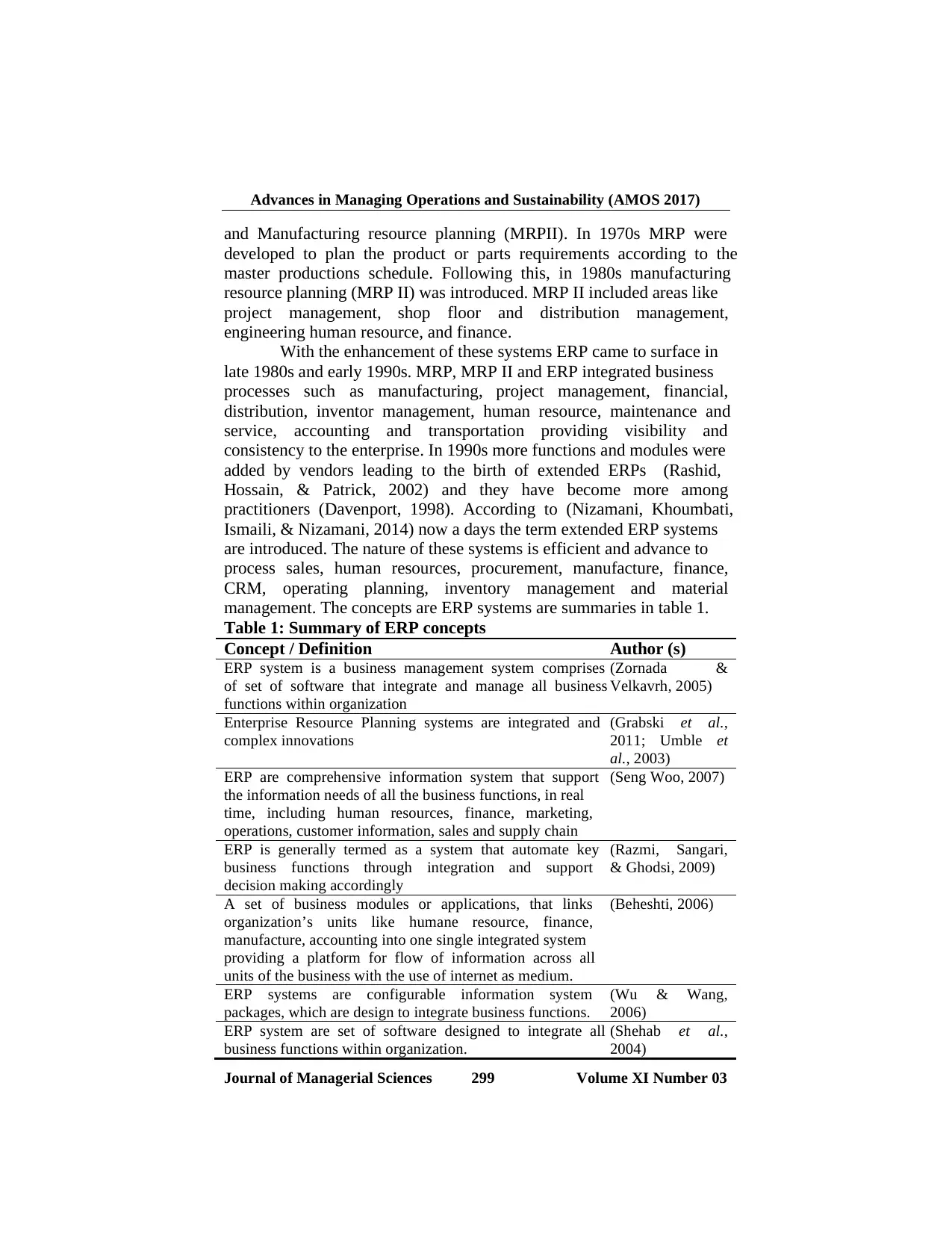
Advances in Managing Operations and Sustainability (AMOS 2017)
Journal of Managerial Sciences 299 Volume XI Number 03
and Manufacturing resource planning (MRPII). In 1970s MRP were
developed to plan the product or parts requirements according to the
master productions schedule. Following this, in 1980s manufacturing
resource planning (MRP II) was introduced. MRP II included areas like
project management, shop floor and distribution management,
engineering human resource, and finance.
With the enhancement of these systems ERP came to surface in
late 1980s and early 1990s. MRP, MRP II and ERP integrated business
processes such as manufacturing, project management, financial,
distribution, inventor management, human resource, maintenance and
service, accounting and transportation providing visibility and
consistency to the enterprise. In 1990s more functions and modules were
added by vendors leading to the birth of extended ERPs (Rashid,
Hossain, & Patrick, 2002) and they have become more among
practitioners (Davenport, 1998). According to (Nizamani, Khoumbati,
Ismaili, & Nizamani, 2014) now a days the term extended ERP systems
are introduced. The nature of these systems is efficient and advance to
process sales, human resources, procurement, manufacture, finance,
CRM, operating planning, inventory management and material
management. The concepts are ERP systems are summaries in table 1.
Table 1: Summary of ERP concepts
Concept / Definition Author (s)
ERP system is a business management system comprises
of set of software that integrate and manage all business
functions within organization
(Zornada &
Velkavrh, 2005)
Enterprise Resource Planning systems are integrated and
complex innovations
(Grabski et al.,
2011; Umble et
al., 2003)
ERP are comprehensive information system that support
the information needs of all the business functions, in real
time, including human resources, finance, marketing,
operations, customer information, sales and supply chain
(Seng Woo, 2007)
ERP is generally termed as a system that automate key
business functions through integration and support
decision making accordingly
(Razmi, Sangari,
& Ghodsi, 2009)
A set of business modules or applications, that links
organization’s units like humane resource, finance,
manufacture, accounting into one single integrated system
providing a platform for flow of information across all
units of the business with the use of internet as medium.
(Beheshti, 2006)
ERP systems are configurable information system
packages, which are design to integrate business functions.
(Wu & Wang,
2006)
ERP system are set of software designed to integrate all
business functions within organization.
(Shehab et al.,
2004)
Journal of Managerial Sciences 299 Volume XI Number 03
and Manufacturing resource planning (MRPII). In 1970s MRP were
developed to plan the product or parts requirements according to the
master productions schedule. Following this, in 1980s manufacturing
resource planning (MRP II) was introduced. MRP II included areas like
project management, shop floor and distribution management,
engineering human resource, and finance.
With the enhancement of these systems ERP came to surface in
late 1980s and early 1990s. MRP, MRP II and ERP integrated business
processes such as manufacturing, project management, financial,
distribution, inventor management, human resource, maintenance and
service, accounting and transportation providing visibility and
consistency to the enterprise. In 1990s more functions and modules were
added by vendors leading to the birth of extended ERPs (Rashid,
Hossain, & Patrick, 2002) and they have become more among
practitioners (Davenport, 1998). According to (Nizamani, Khoumbati,
Ismaili, & Nizamani, 2014) now a days the term extended ERP systems
are introduced. The nature of these systems is efficient and advance to
process sales, human resources, procurement, manufacture, finance,
CRM, operating planning, inventory management and material
management. The concepts are ERP systems are summaries in table 1.
Table 1: Summary of ERP concepts
Concept / Definition Author (s)
ERP system is a business management system comprises
of set of software that integrate and manage all business
functions within organization
(Zornada &
Velkavrh, 2005)
Enterprise Resource Planning systems are integrated and
complex innovations
(Grabski et al.,
2011; Umble et
al., 2003)
ERP are comprehensive information system that support
the information needs of all the business functions, in real
time, including human resources, finance, marketing,
operations, customer information, sales and supply chain
(Seng Woo, 2007)
ERP is generally termed as a system that automate key
business functions through integration and support
decision making accordingly
(Razmi, Sangari,
& Ghodsi, 2009)
A set of business modules or applications, that links
organization’s units like humane resource, finance,
manufacture, accounting into one single integrated system
providing a platform for flow of information across all
units of the business with the use of internet as medium.
(Beheshti, 2006)
ERP systems are configurable information system
packages, which are design to integrate business functions.
(Wu & Wang,
2006)
ERP system are set of software designed to integrate all
business functions within organization.
(Shehab et al.,
2004)
⊘ This is a preview!⊘
Do you want full access?
Subscribe today to unlock all pages.

Trusted by 1+ million students worldwide
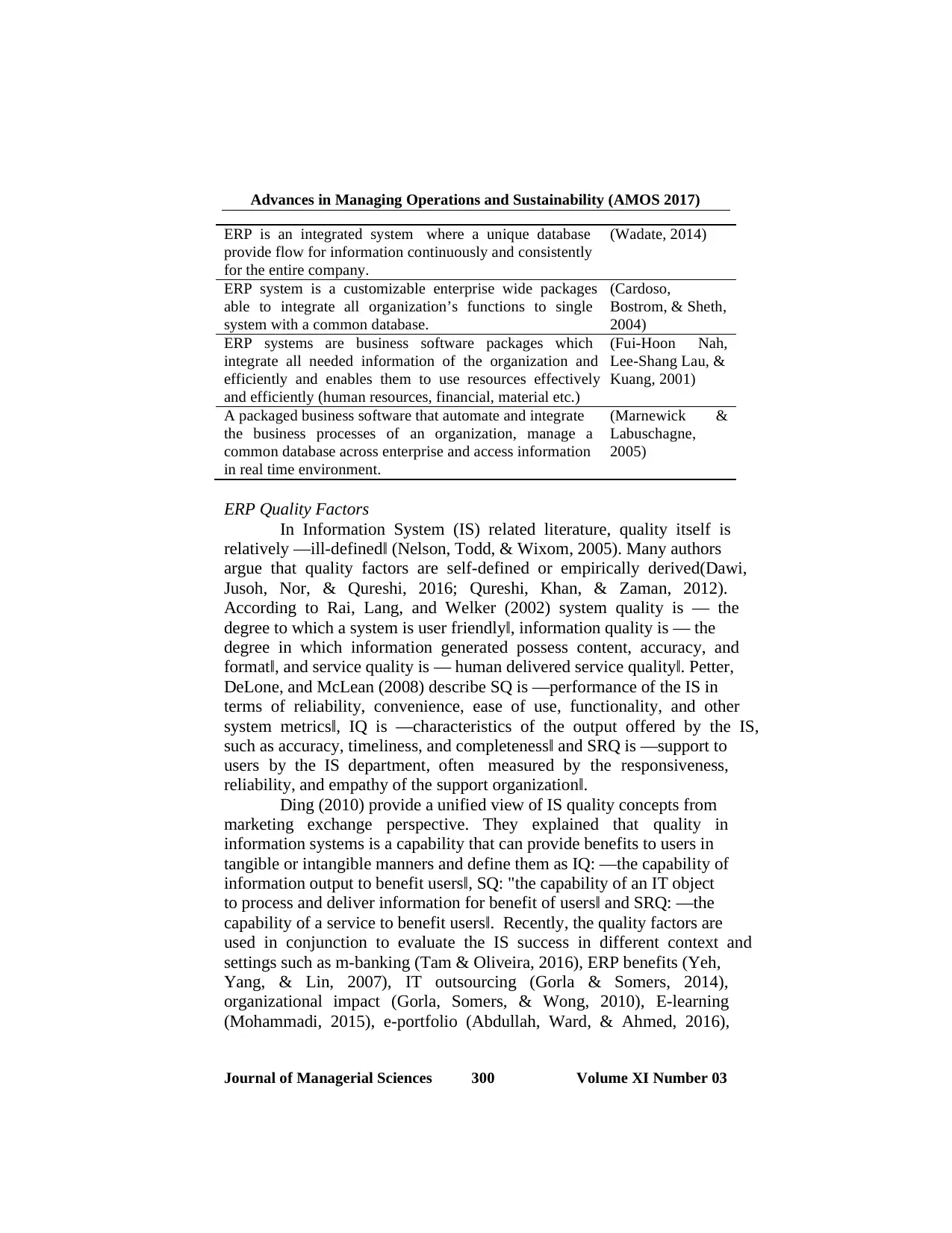
Advances in Managing Operations and Sustainability (AMOS 2017)
Journal of Managerial Sciences 300 Volume XI Number 03
ERP is an integrated system where a unique database
provide flow for information continuously and consistently
for the entire company.
(Wadate, 2014)
ERP system is a customizable enterprise wide packages
able to integrate all organization’s functions to single
system with a common database.
(Cardoso,
Bostrom, & Sheth,
2004)
ERP systems are business software packages which
integrate all needed information of the organization and
efficiently and enables them to use resources effectively
and efficiently (human resources, financial, material etc.)
(Fui-Hoon Nah,
Lee-Shang Lau, &
Kuang, 2001)
A packaged business software that automate and integrate
the business processes of an organization, manage a
common database across enterprise and access information
in real time environment.
(Marnewick &
Labuschagne,
2005)
ERP Quality Factors
In Information System (IS) related literature, quality itself is
relatively ―ill-defined‖ (Nelson, Todd, & Wixom, 2005). Many authors
argue that quality factors are self-defined or empirically derived(Dawi,
Jusoh, Nor, & Qureshi, 2016; Qureshi, Khan, & Zaman, 2012).
According to Rai, Lang, and Welker (2002) system quality is ― the
degree to which a system is user friendly‖, information quality is ― the
degree in which information generated possess content, accuracy, and
format‖, and service quality is ― human delivered service quality‖. Petter,
DeLone, and McLean (2008) describe SQ is ―performance of the IS in
terms of reliability, convenience, ease of use, functionality, and other
system metrics‖, IQ is ―characteristics of the output offered by the IS,
such as accuracy, timeliness, and completeness‖ and SRQ is ―support to
users by the IS department, often measured by the responsiveness,
reliability, and empathy of the support organization‖.
Ding (2010) provide a unified view of IS quality concepts from
marketing exchange perspective. They explained that quality in
information systems is a capability that can provide benefits to users in
tangible or intangible manners and define them as IQ: ―the capability of
information output to benefit users‖, SQ: "the capability of an IT object
to process and deliver information for benefit of users‖ and SRQ: ―the
capability of a service to benefit users‖. Recently, the quality factors are
used in conjunction to evaluate the IS success in different context and
settings such as m-banking (Tam & Oliveira, 2016), ERP benefits (Yeh,
Yang, & Lin, 2007), IT outsourcing (Gorla & Somers, 2014),
organizational impact (Gorla, Somers, & Wong, 2010), E-learning
(Mohammadi, 2015), e-portfolio (Abdullah, Ward, & Ahmed, 2016),
Journal of Managerial Sciences 300 Volume XI Number 03
ERP is an integrated system where a unique database
provide flow for information continuously and consistently
for the entire company.
(Wadate, 2014)
ERP system is a customizable enterprise wide packages
able to integrate all organization’s functions to single
system with a common database.
(Cardoso,
Bostrom, & Sheth,
2004)
ERP systems are business software packages which
integrate all needed information of the organization and
efficiently and enables them to use resources effectively
and efficiently (human resources, financial, material etc.)
(Fui-Hoon Nah,
Lee-Shang Lau, &
Kuang, 2001)
A packaged business software that automate and integrate
the business processes of an organization, manage a
common database across enterprise and access information
in real time environment.
(Marnewick &
Labuschagne,
2005)
ERP Quality Factors
In Information System (IS) related literature, quality itself is
relatively ―ill-defined‖ (Nelson, Todd, & Wixom, 2005). Many authors
argue that quality factors are self-defined or empirically derived(Dawi,
Jusoh, Nor, & Qureshi, 2016; Qureshi, Khan, & Zaman, 2012).
According to Rai, Lang, and Welker (2002) system quality is ― the
degree to which a system is user friendly‖, information quality is ― the
degree in which information generated possess content, accuracy, and
format‖, and service quality is ― human delivered service quality‖. Petter,
DeLone, and McLean (2008) describe SQ is ―performance of the IS in
terms of reliability, convenience, ease of use, functionality, and other
system metrics‖, IQ is ―characteristics of the output offered by the IS,
such as accuracy, timeliness, and completeness‖ and SRQ is ―support to
users by the IS department, often measured by the responsiveness,
reliability, and empathy of the support organization‖.
Ding (2010) provide a unified view of IS quality concepts from
marketing exchange perspective. They explained that quality in
information systems is a capability that can provide benefits to users in
tangible or intangible manners and define them as IQ: ―the capability of
information output to benefit users‖, SQ: "the capability of an IT object
to process and deliver information for benefit of users‖ and SRQ: ―the
capability of a service to benefit users‖. Recently, the quality factors are
used in conjunction to evaluate the IS success in different context and
settings such as m-banking (Tam & Oliveira, 2016), ERP benefits (Yeh,
Yang, & Lin, 2007), IT outsourcing (Gorla & Somers, 2014),
organizational impact (Gorla, Somers, & Wong, 2010), E-learning
(Mohammadi, 2015), e-portfolio (Abdullah, Ward, & Ahmed, 2016),
Paraphrase This Document
Need a fresh take? Get an instant paraphrase of this document with our AI Paraphraser
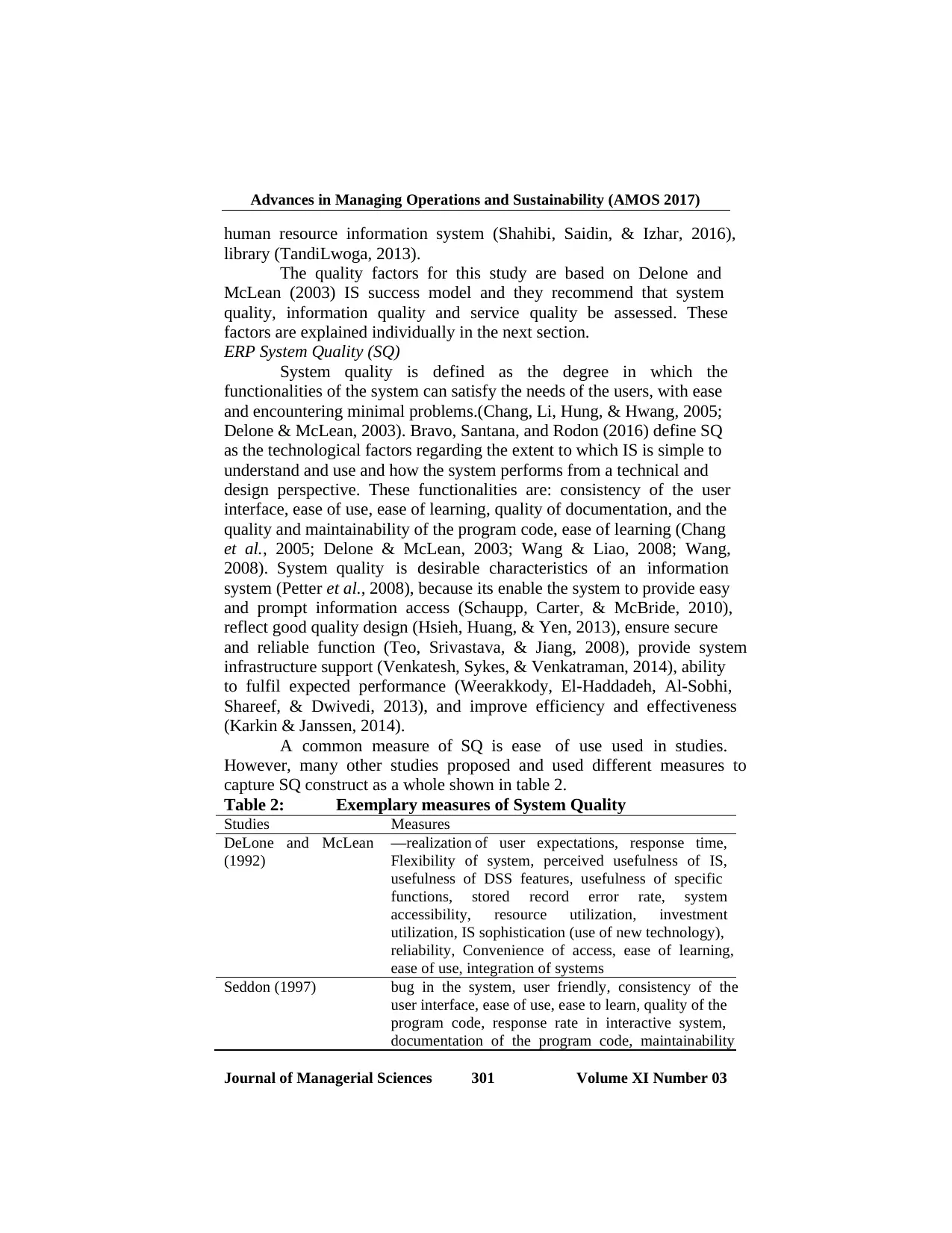
Advances in Managing Operations and Sustainability (AMOS 2017)
Journal of Managerial Sciences 301 Volume XI Number 03
human resource information system (Shahibi, Saidin, & Izhar, 2016),
library (TandiLwoga, 2013).
The quality factors for this study are based on Delone and
McLean (2003) IS success model and they recommend that system
quality, information quality and service quality be assessed. These
factors are explained individually in the next section.
ERP System Quality (SQ)
System quality is defined as the degree in which the
functionalities of the system can satisfy the needs of the users, with ease
and encountering minimal problems.(Chang, Li, Hung, & Hwang, 2005;
Delone & McLean, 2003). Bravo, Santana, and Rodon (2016) define SQ
as the technological factors regarding the extent to which IS is simple to
understand and use and how the system performs from a technical and
design perspective. These functionalities are: consistency of the user
interface, ease of use, ease of learning, quality of documentation, and the
quality and maintainability of the program code, ease of learning (Chang
et al., 2005; Delone & McLean, 2003; Wang & Liao, 2008; Wang,
2008). System quality is desirable characteristics of an information
system (Petter et al., 2008), because its enable the system to provide easy
and prompt information access (Schaupp, Carter, & McBride, 2010),
reflect good quality design (Hsieh, Huang, & Yen, 2013), ensure secure
and reliable function (Teo, Srivastava, & Jiang, 2008), provide system
infrastructure support (Venkatesh, Sykes, & Venkatraman, 2014), ability
to fulfil expected performance (Weerakkody, El-Haddadeh, Al-Sobhi,
Shareef, & Dwivedi, 2013), and improve efficiency and effectiveness
(Karkin & Janssen, 2014).
A common measure of SQ is ease of use used in studies.
However, many other studies proposed and used different measures to
capture SQ construct as a whole shown in table 2.
Table 2: Exemplary measures of System Quality
Studies Measures
DeLone and McLean
(1992)
―realization of user expectations, response time,
Flexibility of system, perceived usefulness of IS,
usefulness of DSS features, usefulness of specific
functions, stored record error rate, system
accessibility, resource utilization, investment
utilization, IS sophistication (use of new technology),
reliability, Convenience of access, ease of learning,
ease of use, integration of systems
Seddon (1997) bug in the system, user friendly, consistency of the
user interface, ease of use, ease to learn, quality of the
program code, response rate in interactive system,
documentation of the program code, maintainability
Journal of Managerial Sciences 301 Volume XI Number 03
human resource information system (Shahibi, Saidin, & Izhar, 2016),
library (TandiLwoga, 2013).
The quality factors for this study are based on Delone and
McLean (2003) IS success model and they recommend that system
quality, information quality and service quality be assessed. These
factors are explained individually in the next section.
ERP System Quality (SQ)
System quality is defined as the degree in which the
functionalities of the system can satisfy the needs of the users, with ease
and encountering minimal problems.(Chang, Li, Hung, & Hwang, 2005;
Delone & McLean, 2003). Bravo, Santana, and Rodon (2016) define SQ
as the technological factors regarding the extent to which IS is simple to
understand and use and how the system performs from a technical and
design perspective. These functionalities are: consistency of the user
interface, ease of use, ease of learning, quality of documentation, and the
quality and maintainability of the program code, ease of learning (Chang
et al., 2005; Delone & McLean, 2003; Wang & Liao, 2008; Wang,
2008). System quality is desirable characteristics of an information
system (Petter et al., 2008), because its enable the system to provide easy
and prompt information access (Schaupp, Carter, & McBride, 2010),
reflect good quality design (Hsieh, Huang, & Yen, 2013), ensure secure
and reliable function (Teo, Srivastava, & Jiang, 2008), provide system
infrastructure support (Venkatesh, Sykes, & Venkatraman, 2014), ability
to fulfil expected performance (Weerakkody, El-Haddadeh, Al-Sobhi,
Shareef, & Dwivedi, 2013), and improve efficiency and effectiveness
(Karkin & Janssen, 2014).
A common measure of SQ is ease of use used in studies.
However, many other studies proposed and used different measures to
capture SQ construct as a whole shown in table 2.
Table 2: Exemplary measures of System Quality
Studies Measures
DeLone and McLean
(1992)
―realization of user expectations, response time,
Flexibility of system, perceived usefulness of IS,
usefulness of DSS features, usefulness of specific
functions, stored record error rate, system
accessibility, resource utilization, investment
utilization, IS sophistication (use of new technology),
reliability, Convenience of access, ease of learning,
ease of use, integration of systems
Seddon (1997) bug in the system, user friendly, consistency of the
user interface, ease of use, ease to learn, quality of the
program code, response rate in interactive system,
documentation of the program code, maintainability
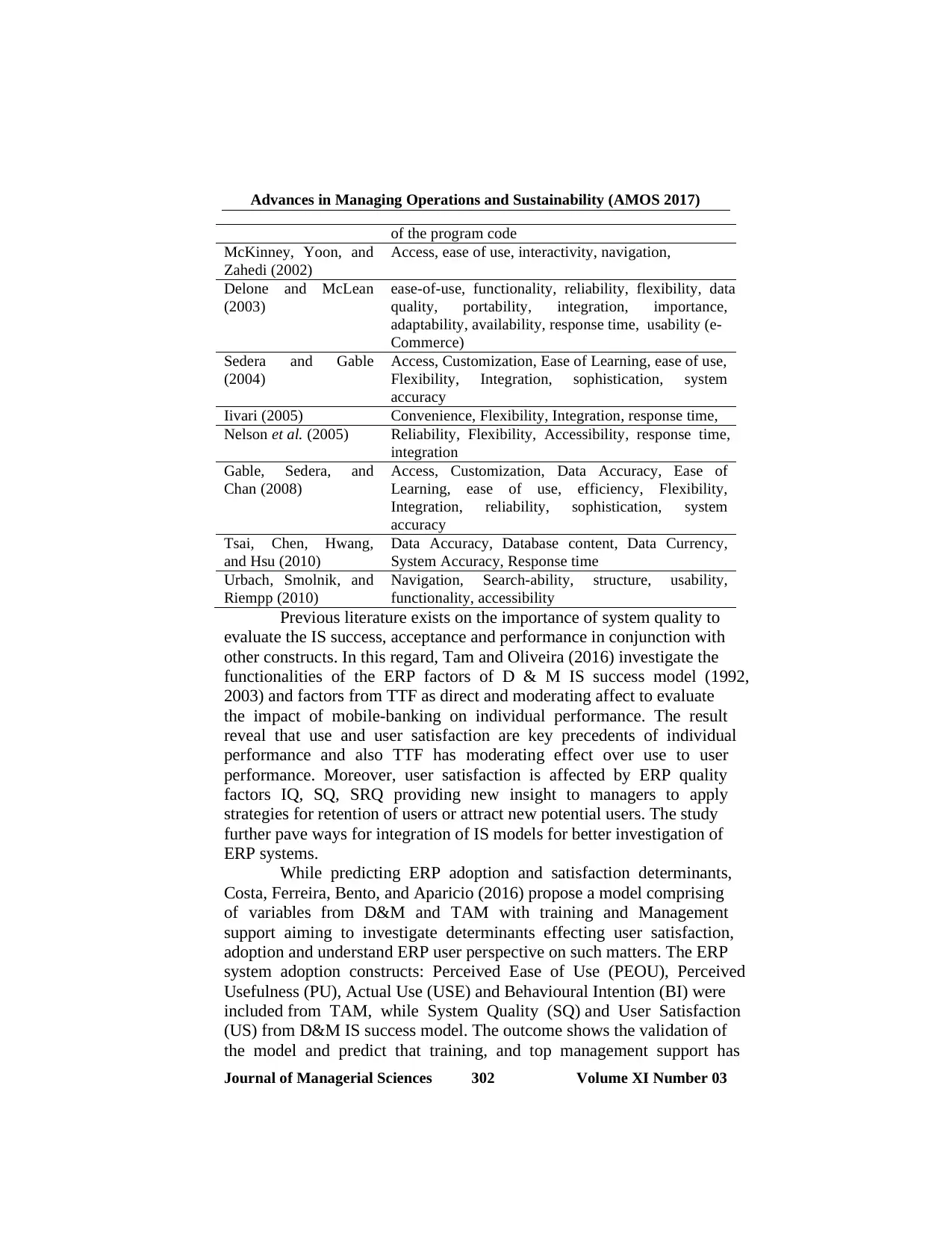
Advances in Managing Operations and Sustainability (AMOS 2017)
Journal of Managerial Sciences 302 Volume XI Number 03
of the program code
McKinney, Yoon, and
Zahedi (2002)
Access, ease of use, interactivity, navigation,
Delone and McLean
(2003)
ease-of-use, functionality, reliability, flexibility, data
quality, portability, integration, importance,
adaptability, availability, response time, usability (e-
Commerce)
Sedera and Gable
(2004)
Access, Customization, Ease of Learning, ease of use,
Flexibility, Integration, sophistication, system
accuracy
Iivari (2005) Convenience, Flexibility, Integration, response time,
Nelson et al. (2005) Reliability, Flexibility, Accessibility, response time,
integration
Gable, Sedera, and
Chan (2008)
Access, Customization, Data Accuracy, Ease of
Learning, ease of use, efficiency, Flexibility,
Integration, reliability, sophistication, system
accuracy
Tsai, Chen, Hwang,
and Hsu (2010)
Data Accuracy, Database content, Data Currency,
System Accuracy, Response time
Urbach, Smolnik, and
Riempp (2010)
Navigation, Search-ability, structure, usability,
functionality, accessibility
Previous literature exists on the importance of system quality to
evaluate the IS success, acceptance and performance in conjunction with
other constructs. In this regard, Tam and Oliveira (2016) investigate the
functionalities of the ERP factors of D & M IS success model (1992,
2003) and factors from TTF as direct and moderating affect to evaluate
the impact of mobile-banking on individual performance. The result
reveal that use and user satisfaction are key precedents of individual
performance and also TTF has moderating effect over use to user
performance. Moreover, user satisfaction is affected by ERP quality
factors IQ, SQ, SRQ providing new insight to managers to apply
strategies for retention of users or attract new potential users. The study
further pave ways for integration of IS models for better investigation of
ERP systems.
While predicting ERP adoption and satisfaction determinants,
Costa, Ferreira, Bento, and Aparicio (2016) propose a model comprising
of variables from D&M and TAM with training and Management
support aiming to investigate determinants effecting user satisfaction,
adoption and understand ERP user perspective on such matters. The ERP
system adoption constructs: Perceived Ease of Use (PEOU), Perceived
Usefulness (PU), Actual Use (USE) and Behavioural Intention (BI) were
included from TAM, while System Quality (SQ) and User Satisfaction
(US) from D&M IS success model. The outcome shows the validation of
the model and predict that training, and top management support has
Journal of Managerial Sciences 302 Volume XI Number 03
of the program code
McKinney, Yoon, and
Zahedi (2002)
Access, ease of use, interactivity, navigation,
Delone and McLean
(2003)
ease-of-use, functionality, reliability, flexibility, data
quality, portability, integration, importance,
adaptability, availability, response time, usability (e-
Commerce)
Sedera and Gable
(2004)
Access, Customization, Ease of Learning, ease of use,
Flexibility, Integration, sophistication, system
accuracy
Iivari (2005) Convenience, Flexibility, Integration, response time,
Nelson et al. (2005) Reliability, Flexibility, Accessibility, response time,
integration
Gable, Sedera, and
Chan (2008)
Access, Customization, Data Accuracy, Ease of
Learning, ease of use, efficiency, Flexibility,
Integration, reliability, sophistication, system
accuracy
Tsai, Chen, Hwang,
and Hsu (2010)
Data Accuracy, Database content, Data Currency,
System Accuracy, Response time
Urbach, Smolnik, and
Riempp (2010)
Navigation, Search-ability, structure, usability,
functionality, accessibility
Previous literature exists on the importance of system quality to
evaluate the IS success, acceptance and performance in conjunction with
other constructs. In this regard, Tam and Oliveira (2016) investigate the
functionalities of the ERP factors of D & M IS success model (1992,
2003) and factors from TTF as direct and moderating affect to evaluate
the impact of mobile-banking on individual performance. The result
reveal that use and user satisfaction are key precedents of individual
performance and also TTF has moderating effect over use to user
performance. Moreover, user satisfaction is affected by ERP quality
factors IQ, SQ, SRQ providing new insight to managers to apply
strategies for retention of users or attract new potential users. The study
further pave ways for integration of IS models for better investigation of
ERP systems.
While predicting ERP adoption and satisfaction determinants,
Costa, Ferreira, Bento, and Aparicio (2016) propose a model comprising
of variables from D&M and TAM with training and Management
support aiming to investigate determinants effecting user satisfaction,
adoption and understand ERP user perspective on such matters. The ERP
system adoption constructs: Perceived Ease of Use (PEOU), Perceived
Usefulness (PU), Actual Use (USE) and Behavioural Intention (BI) were
included from TAM, while System Quality (SQ) and User Satisfaction
(US) from D&M IS success model. The outcome shows the validation of
the model and predict that training, and top management support has
⊘ This is a preview!⊘
Do you want full access?
Subscribe today to unlock all pages.

Trusted by 1+ million students worldwide
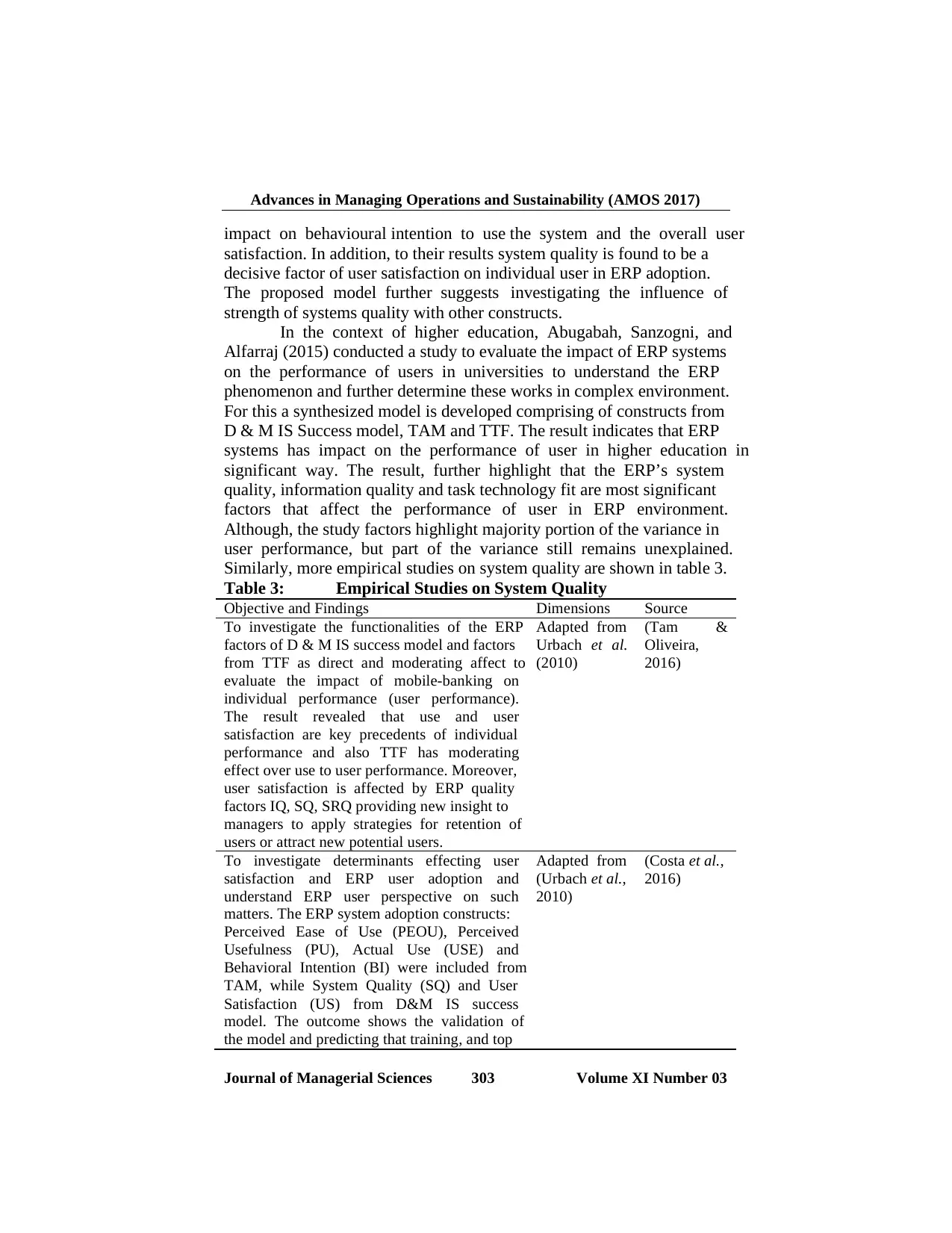
Advances in Managing Operations and Sustainability (AMOS 2017)
Journal of Managerial Sciences 303 Volume XI Number 03
impact on behavioural intention to use the system and the overall user
satisfaction. In addition, to their results system quality is found to be a
decisive factor of user satisfaction on individual user in ERP adoption.
The proposed model further suggests investigating the influence of
strength of systems quality with other constructs.
In the context of higher education, Abugabah, Sanzogni, and
Alfarraj (2015) conducted a study to evaluate the impact of ERP systems
on the performance of users in universities to understand the ERP
phenomenon and further determine these works in complex environment.
For this a synthesized model is developed comprising of constructs from
D & M IS Success model, TAM and TTF. The result indicates that ERP
systems has impact on the performance of user in higher education in
significant way. The result, further highlight that the ERP’s system
quality, information quality and task technology fit are most significant
factors that affect the performance of user in ERP environment.
Although, the study factors highlight majority portion of the variance in
user performance, but part of the variance still remains unexplained.
Similarly, more empirical studies on system quality are shown in table 3.
Table 3: Empirical Studies on System Quality
Objective and Findings Dimensions Source
To investigate the functionalities of the ERP
factors of D & M IS success model and factors
from TTF as direct and moderating affect to
evaluate the impact of mobile-banking on
individual performance (user performance).
The result revealed that use and user
satisfaction are key precedents of individual
performance and also TTF has moderating
effect over use to user performance. Moreover,
user satisfaction is affected by ERP quality
factors IQ, SQ, SRQ providing new insight to
managers to apply strategies for retention of
users or attract new potential users.
Adapted from
Urbach et al.
(2010)
(Tam &
Oliveira,
2016)
To investigate determinants effecting user
satisfaction and ERP user adoption and
understand ERP user perspective on such
matters. The ERP system adoption constructs:
Perceived Ease of Use (PEOU), Perceived
Usefulness (PU), Actual Use (USE) and
Behavioral Intention (BI) were included from
TAM, while System Quality (SQ) and User
Satisfaction (US) from D&M IS success
model. The outcome shows the validation of
the model and predicting that training, and top
Adapted from
(Urbach et al.,
2010)
(Costa et al.,
2016)
Journal of Managerial Sciences 303 Volume XI Number 03
impact on behavioural intention to use the system and the overall user
satisfaction. In addition, to their results system quality is found to be a
decisive factor of user satisfaction on individual user in ERP adoption.
The proposed model further suggests investigating the influence of
strength of systems quality with other constructs.
In the context of higher education, Abugabah, Sanzogni, and
Alfarraj (2015) conducted a study to evaluate the impact of ERP systems
on the performance of users in universities to understand the ERP
phenomenon and further determine these works in complex environment.
For this a synthesized model is developed comprising of constructs from
D & M IS Success model, TAM and TTF. The result indicates that ERP
systems has impact on the performance of user in higher education in
significant way. The result, further highlight that the ERP’s system
quality, information quality and task technology fit are most significant
factors that affect the performance of user in ERP environment.
Although, the study factors highlight majority portion of the variance in
user performance, but part of the variance still remains unexplained.
Similarly, more empirical studies on system quality are shown in table 3.
Table 3: Empirical Studies on System Quality
Objective and Findings Dimensions Source
To investigate the functionalities of the ERP
factors of D & M IS success model and factors
from TTF as direct and moderating affect to
evaluate the impact of mobile-banking on
individual performance (user performance).
The result revealed that use and user
satisfaction are key precedents of individual
performance and also TTF has moderating
effect over use to user performance. Moreover,
user satisfaction is affected by ERP quality
factors IQ, SQ, SRQ providing new insight to
managers to apply strategies for retention of
users or attract new potential users.
Adapted from
Urbach et al.
(2010)
(Tam &
Oliveira,
2016)
To investigate determinants effecting user
satisfaction and ERP user adoption and
understand ERP user perspective on such
matters. The ERP system adoption constructs:
Perceived Ease of Use (PEOU), Perceived
Usefulness (PU), Actual Use (USE) and
Behavioral Intention (BI) were included from
TAM, while System Quality (SQ) and User
Satisfaction (US) from D&M IS success
model. The outcome shows the validation of
the model and predicting that training, and top
Adapted from
(Urbach et al.,
2010)
(Costa et al.,
2016)
Paraphrase This Document
Need a fresh take? Get an instant paraphrase of this document with our AI Paraphraser
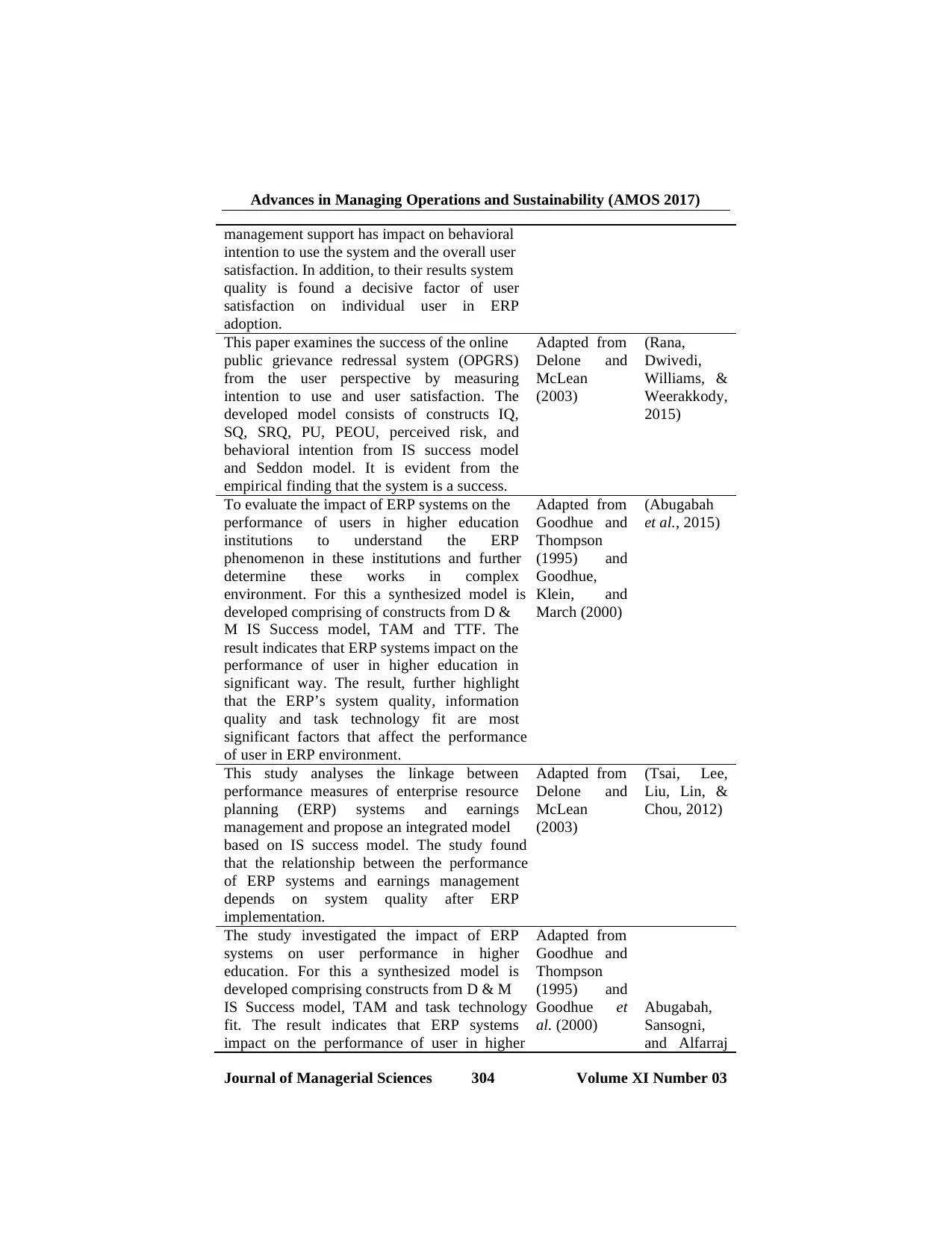
Advances in Managing Operations and Sustainability (AMOS 2017)
Journal of Managerial Sciences 304 Volume XI Number 03
management support has impact on behavioral
intention to use the system and the overall user
satisfaction. In addition, to their results system
quality is found a decisive factor of user
satisfaction on individual user in ERP
adoption.
This paper examines the success of the online
public grievance redressal system (OPGRS)
from the user perspective by measuring
intention to use and user satisfaction. The
developed model consists of constructs IQ,
SQ, SRQ, PU, PEOU, perceived risk, and
behavioral intention from IS success model
and Seddon model. It is evident from the
empirical finding that the system is a success.
Adapted from
Delone and
McLean
(2003)
(Rana,
Dwivedi,
Williams, &
Weerakkody,
2015)
To evaluate the impact of ERP systems on the
performance of users in higher education
institutions to understand the ERP
phenomenon in these institutions and further
determine these works in complex
environment. For this a synthesized model is
developed comprising of constructs from D &
M IS Success model, TAM and TTF. The
result indicates that ERP systems impact on the
performance of user in higher education in
significant way. The result, further highlight
that the ERP’s system quality, information
quality and task technology fit are most
significant factors that affect the performance
of user in ERP environment.
Adapted from
Goodhue and
Thompson
(1995) and
Goodhue,
Klein, and
March (2000)
(Abugabah
et al., 2015)
This study analyses the linkage between
performance measures of enterprise resource
planning (ERP) systems and earnings
management and propose an integrated model
based on IS success model. The study found
that the relationship between the performance
of ERP systems and earnings management
depends on system quality after ERP
implementation.
Adapted from
Delone and
McLean
(2003)
(Tsai, Lee,
Liu, Lin, &
Chou, 2012)
The study investigated the impact of ERP
systems on user performance in higher
education. For this a synthesized model is
developed comprising constructs from D & M
IS Success model, TAM and task technology
fit. The result indicates that ERP systems
impact on the performance of user in higher
Adapted from
Goodhue and
Thompson
(1995) and
Goodhue et
al. (2000)
Abugabah,
Sansogni,
and Alfarraj
Journal of Managerial Sciences 304 Volume XI Number 03
management support has impact on behavioral
intention to use the system and the overall user
satisfaction. In addition, to their results system
quality is found a decisive factor of user
satisfaction on individual user in ERP
adoption.
This paper examines the success of the online
public grievance redressal system (OPGRS)
from the user perspective by measuring
intention to use and user satisfaction. The
developed model consists of constructs IQ,
SQ, SRQ, PU, PEOU, perceived risk, and
behavioral intention from IS success model
and Seddon model. It is evident from the
empirical finding that the system is a success.
Adapted from
Delone and
McLean
(2003)
(Rana,
Dwivedi,
Williams, &
Weerakkody,
2015)
To evaluate the impact of ERP systems on the
performance of users in higher education
institutions to understand the ERP
phenomenon in these institutions and further
determine these works in complex
environment. For this a synthesized model is
developed comprising of constructs from D &
M IS Success model, TAM and TTF. The
result indicates that ERP systems impact on the
performance of user in higher education in
significant way. The result, further highlight
that the ERP’s system quality, information
quality and task technology fit are most
significant factors that affect the performance
of user in ERP environment.
Adapted from
Goodhue and
Thompson
(1995) and
Goodhue,
Klein, and
March (2000)
(Abugabah
et al., 2015)
This study analyses the linkage between
performance measures of enterprise resource
planning (ERP) systems and earnings
management and propose an integrated model
based on IS success model. The study found
that the relationship between the performance
of ERP systems and earnings management
depends on system quality after ERP
implementation.
Adapted from
Delone and
McLean
(2003)
(Tsai, Lee,
Liu, Lin, &
Chou, 2012)
The study investigated the impact of ERP
systems on user performance in higher
education. For this a synthesized model is
developed comprising constructs from D & M
IS Success model, TAM and task technology
fit. The result indicates that ERP systems
impact on the performance of user in higher
Adapted from
Goodhue and
Thompson
(1995) and
Goodhue et
al. (2000)
Abugabah,
Sansogni,
and Alfarraj
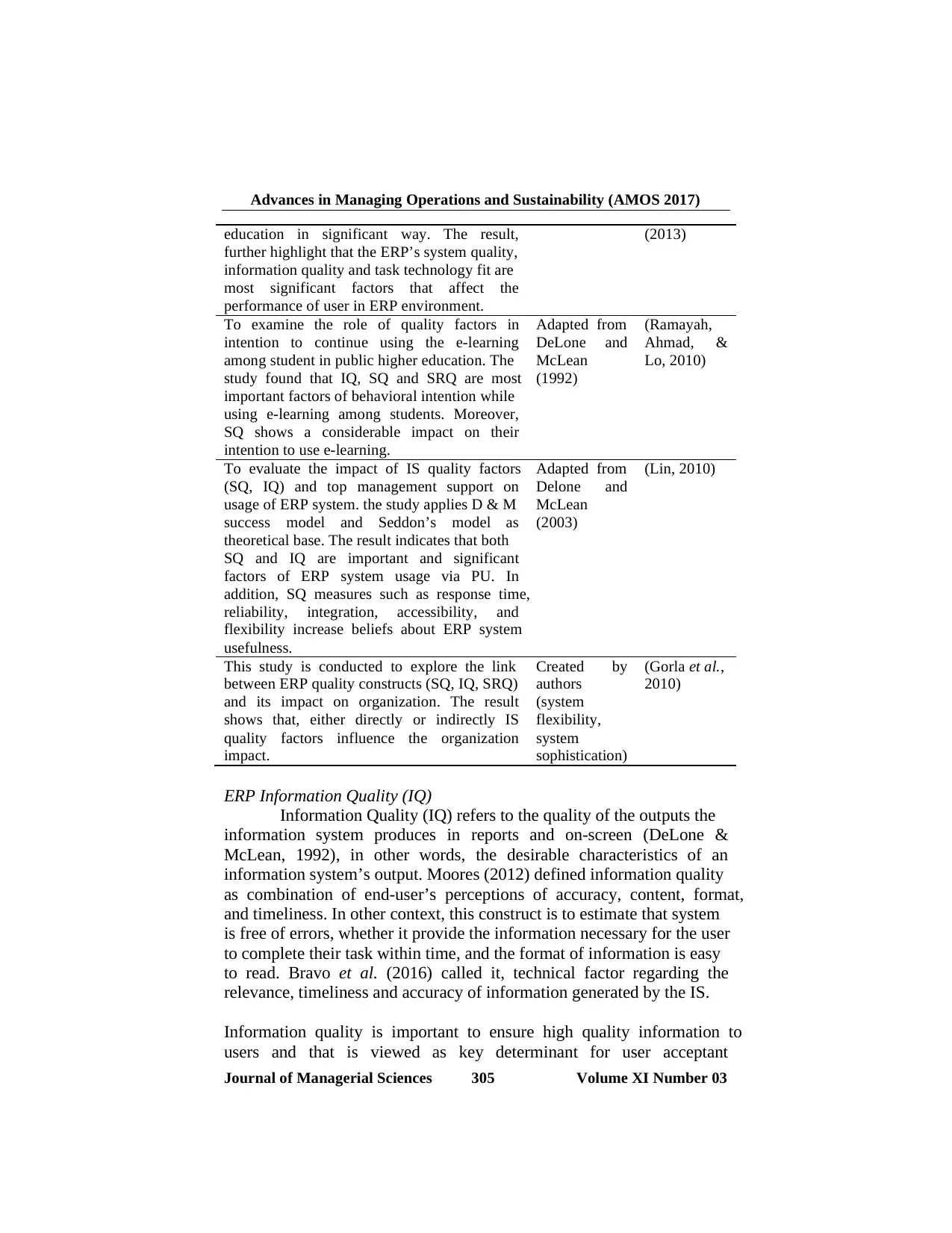
Advances in Managing Operations and Sustainability (AMOS 2017)
Journal of Managerial Sciences 305 Volume XI Number 03
education in significant way. The result,
further highlight that the ERP’s system quality,
information quality and task technology fit are
most significant factors that affect the
performance of user in ERP environment.
(2013)
To examine the role of quality factors in
intention to continue using the e-learning
among student in public higher education. The
study found that IQ, SQ and SRQ are most
important factors of behavioral intention while
using e-learning among students. Moreover,
SQ shows a considerable impact on their
intention to use e-learning.
Adapted from
DeLone and
McLean
(1992)
(Ramayah,
Ahmad, &
Lo, 2010)
To evaluate the impact of IS quality factors
(SQ, IQ) and top management support on
usage of ERP system. the study applies D & M
success model and Seddon’s model as
theoretical base. The result indicates that both
SQ and IQ are important and significant
factors of ERP system usage via PU. In
addition, SQ measures such as response time,
reliability, integration, accessibility, and
flexibility increase beliefs about ERP system
usefulness.
Adapted from
Delone and
McLean
(2003)
(Lin, 2010)
This study is conducted to explore the link
between ERP quality constructs (SQ, IQ, SRQ)
and its impact on organization. The result
shows that, either directly or indirectly IS
quality factors influence the organization
impact.
Created by
authors
(system
flexibility,
system
sophistication)
(Gorla et al.,
2010)
ERP Information Quality (IQ)
Information Quality (IQ) refers to the quality of the outputs the
information system produces in reports and on-screen (DeLone &
McLean, 1992), in other words, the desirable characteristics of an
information system’s output. Moores (2012) defined information quality
as combination of end-user’s perceptions of accuracy, content, format,
and timeliness. In other context, this construct is to estimate that system
is free of errors, whether it provide the information necessary for the user
to complete their task within time, and the format of information is easy
to read. Bravo et al. (2016) called it, technical factor regarding the
relevance, timeliness and accuracy of information generated by the IS.
Information quality is important to ensure high quality information to
users and that is viewed as key determinant for user acceptant
Journal of Managerial Sciences 305 Volume XI Number 03
education in significant way. The result,
further highlight that the ERP’s system quality,
information quality and task technology fit are
most significant factors that affect the
performance of user in ERP environment.
(2013)
To examine the role of quality factors in
intention to continue using the e-learning
among student in public higher education. The
study found that IQ, SQ and SRQ are most
important factors of behavioral intention while
using e-learning among students. Moreover,
SQ shows a considerable impact on their
intention to use e-learning.
Adapted from
DeLone and
McLean
(1992)
(Ramayah,
Ahmad, &
Lo, 2010)
To evaluate the impact of IS quality factors
(SQ, IQ) and top management support on
usage of ERP system. the study applies D & M
success model and Seddon’s model as
theoretical base. The result indicates that both
SQ and IQ are important and significant
factors of ERP system usage via PU. In
addition, SQ measures such as response time,
reliability, integration, accessibility, and
flexibility increase beliefs about ERP system
usefulness.
Adapted from
Delone and
McLean
(2003)
(Lin, 2010)
This study is conducted to explore the link
between ERP quality constructs (SQ, IQ, SRQ)
and its impact on organization. The result
shows that, either directly or indirectly IS
quality factors influence the organization
impact.
Created by
authors
(system
flexibility,
system
sophistication)
(Gorla et al.,
2010)
ERP Information Quality (IQ)
Information Quality (IQ) refers to the quality of the outputs the
information system produces in reports and on-screen (DeLone &
McLean, 1992), in other words, the desirable characteristics of an
information system’s output. Moores (2012) defined information quality
as combination of end-user’s perceptions of accuracy, content, format,
and timeliness. In other context, this construct is to estimate that system
is free of errors, whether it provide the information necessary for the user
to complete their task within time, and the format of information is easy
to read. Bravo et al. (2016) called it, technical factor regarding the
relevance, timeliness and accuracy of information generated by the IS.
Information quality is important to ensure high quality information to
users and that is viewed as key determinant for user acceptant
⊘ This is a preview!⊘
Do you want full access?
Subscribe today to unlock all pages.

Trusted by 1+ million students worldwide
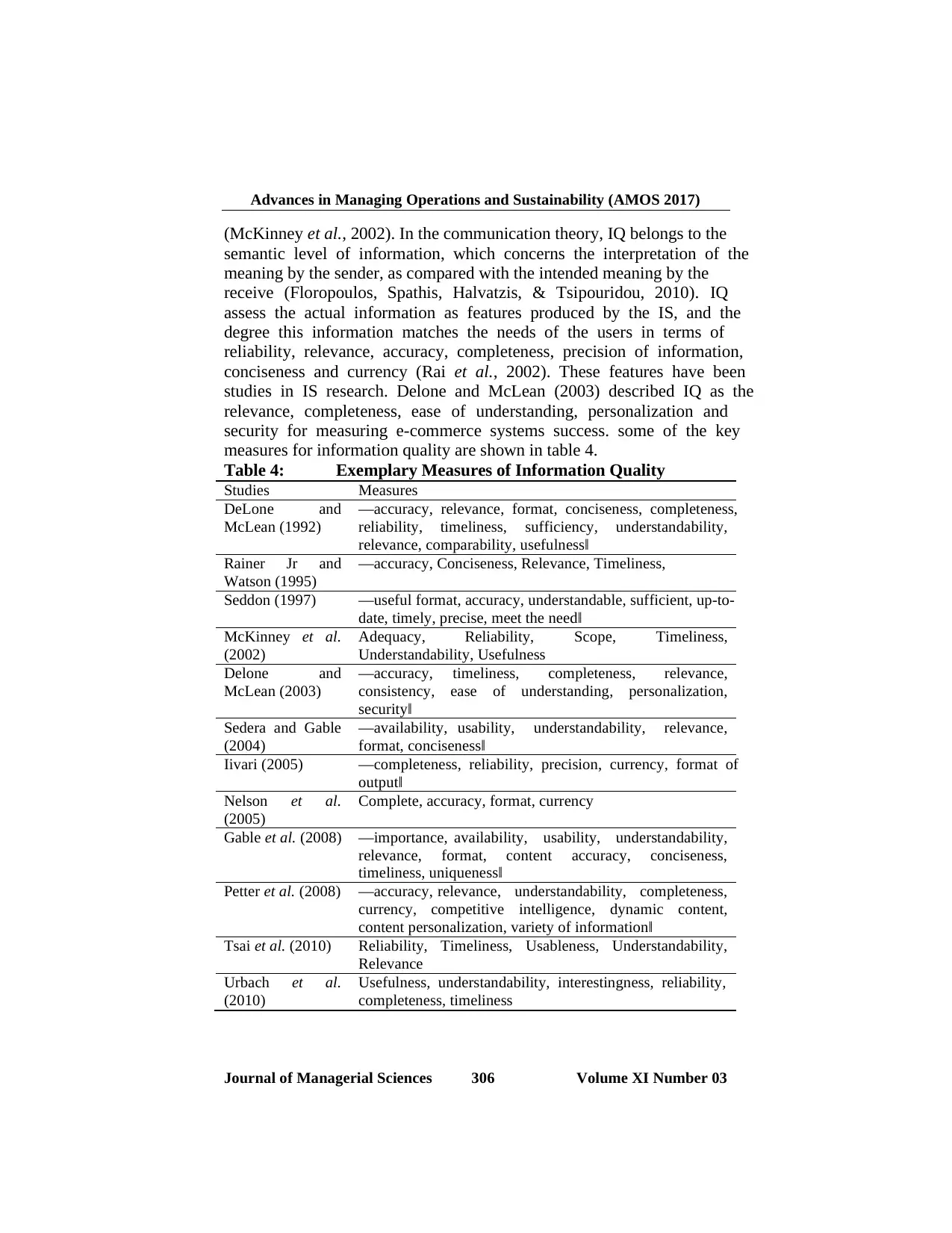
Advances in Managing Operations and Sustainability (AMOS 2017)
Journal of Managerial Sciences 306 Volume XI Number 03
(McKinney et al., 2002). In the communication theory, IQ belongs to the
semantic level of information, which concerns the interpretation of the
meaning by the sender, as compared with the intended meaning by the
receive (Floropoulos, Spathis, Halvatzis, & Tsipouridou, 2010). IQ
assess the actual information as features produced by the IS, and the
degree this information matches the needs of the users in terms of
reliability, relevance, accuracy, completeness, precision of information,
conciseness and currency (Rai et al., 2002). These features have been
studies in IS research. Delone and McLean (2003) described IQ as the
relevance, completeness, ease of understanding, personalization and
security for measuring e-commerce systems success. some of the key
measures for information quality are shown in table 4.
Table 4: Exemplary Measures of Information Quality
Studies Measures
DeLone and
McLean (1992)
―accuracy, relevance, format, conciseness, completeness,
reliability, timeliness, sufficiency, understandability,
relevance, comparability, usefulness‖
Rainer Jr and
Watson (1995)
―accuracy, Conciseness, Relevance, Timeliness,
Seddon (1997) ―useful format, accuracy, understandable, sufficient, up-to-
date, timely, precise, meet the need‖
McKinney et al.
(2002)
Adequacy, Reliability, Scope, Timeliness,
Understandability, Usefulness
Delone and
McLean (2003)
―accuracy, timeliness, completeness, relevance,
consistency, ease of understanding, personalization,
security‖
Sedera and Gable
(2004)
―availability, usability, understandability, relevance,
format, conciseness‖
Iivari (2005) ―completeness, reliability, precision, currency, format of
output‖
Nelson et al.
(2005)
Complete, accuracy, format, currency
Gable et al. (2008) ―importance, availability, usability, understandability,
relevance, format, content accuracy, conciseness,
timeliness, uniqueness‖
Petter et al. (2008) ―accuracy, relevance, understandability, completeness,
currency, competitive intelligence, dynamic content,
content personalization, variety of information‖
Tsai et al. (2010) Reliability, Timeliness, Usableness, Understandability,
Relevance
Urbach et al.
(2010)
Usefulness, understandability, interestingness, reliability,
completeness, timeliness
Journal of Managerial Sciences 306 Volume XI Number 03
(McKinney et al., 2002). In the communication theory, IQ belongs to the
semantic level of information, which concerns the interpretation of the
meaning by the sender, as compared with the intended meaning by the
receive (Floropoulos, Spathis, Halvatzis, & Tsipouridou, 2010). IQ
assess the actual information as features produced by the IS, and the
degree this information matches the needs of the users in terms of
reliability, relevance, accuracy, completeness, precision of information,
conciseness and currency (Rai et al., 2002). These features have been
studies in IS research. Delone and McLean (2003) described IQ as the
relevance, completeness, ease of understanding, personalization and
security for measuring e-commerce systems success. some of the key
measures for information quality are shown in table 4.
Table 4: Exemplary Measures of Information Quality
Studies Measures
DeLone and
McLean (1992)
―accuracy, relevance, format, conciseness, completeness,
reliability, timeliness, sufficiency, understandability,
relevance, comparability, usefulness‖
Rainer Jr and
Watson (1995)
―accuracy, Conciseness, Relevance, Timeliness,
Seddon (1997) ―useful format, accuracy, understandable, sufficient, up-to-
date, timely, precise, meet the need‖
McKinney et al.
(2002)
Adequacy, Reliability, Scope, Timeliness,
Understandability, Usefulness
Delone and
McLean (2003)
―accuracy, timeliness, completeness, relevance,
consistency, ease of understanding, personalization,
security‖
Sedera and Gable
(2004)
―availability, usability, understandability, relevance,
format, conciseness‖
Iivari (2005) ―completeness, reliability, precision, currency, format of
output‖
Nelson et al.
(2005)
Complete, accuracy, format, currency
Gable et al. (2008) ―importance, availability, usability, understandability,
relevance, format, content accuracy, conciseness,
timeliness, uniqueness‖
Petter et al. (2008) ―accuracy, relevance, understandability, completeness,
currency, competitive intelligence, dynamic content,
content personalization, variety of information‖
Tsai et al. (2010) Reliability, Timeliness, Usableness, Understandability,
Relevance
Urbach et al.
(2010)
Usefulness, understandability, interestingness, reliability,
completeness, timeliness
Paraphrase This Document
Need a fresh take? Get an instant paraphrase of this document with our AI Paraphraser
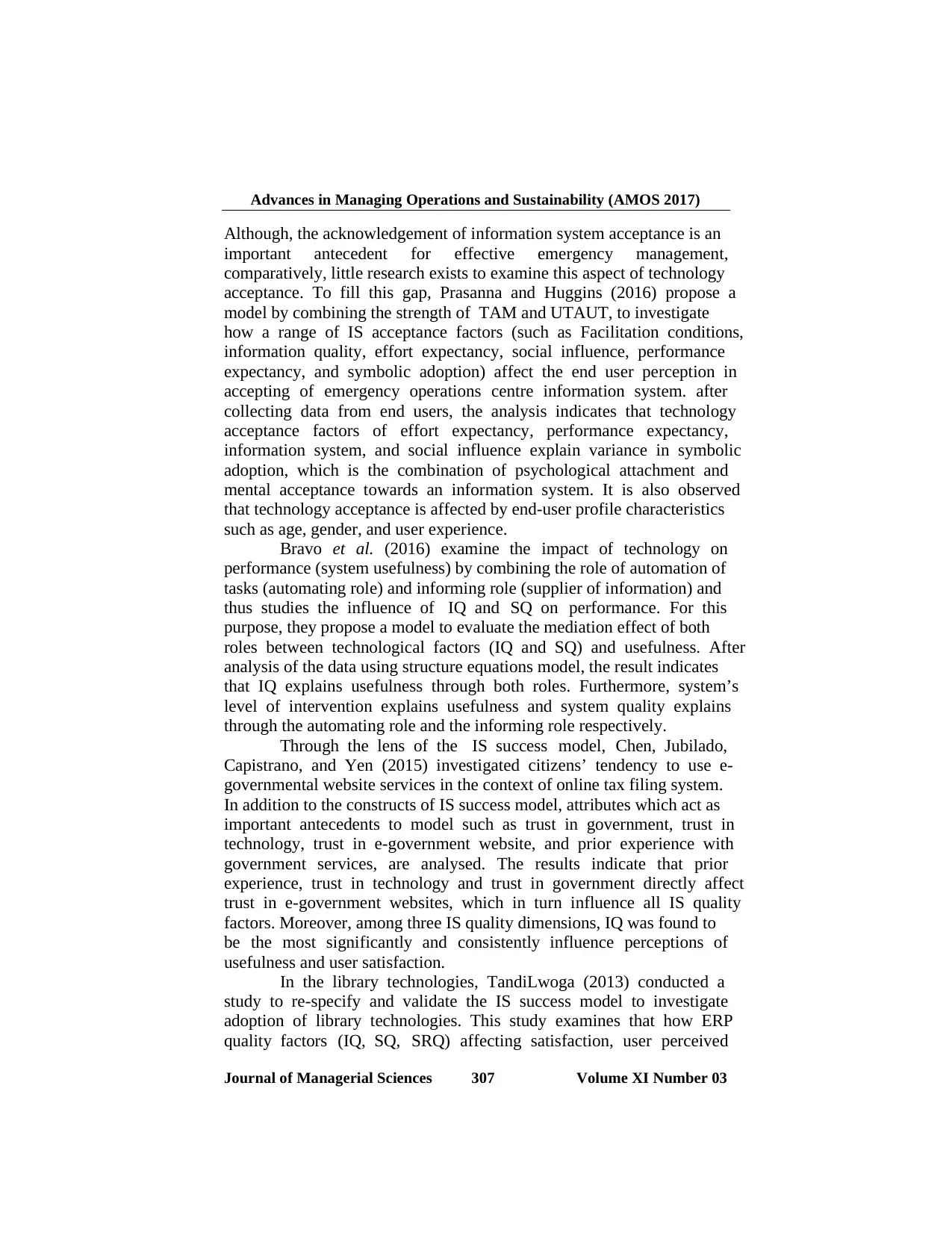
Advances in Managing Operations and Sustainability (AMOS 2017)
Journal of Managerial Sciences 307 Volume XI Number 03
Although, the acknowledgement of information system acceptance is an
important antecedent for effective emergency management,
comparatively, little research exists to examine this aspect of technology
acceptance. To fill this gap, Prasanna and Huggins (2016) propose a
model by combining the strength of TAM and UTAUT, to investigate
how a range of IS acceptance factors (such as Facilitation conditions,
information quality, effort expectancy, social influence, performance
expectancy, and symbolic adoption) affect the end user perception in
accepting of emergency operations centre information system. after
collecting data from end users, the analysis indicates that technology
acceptance factors of effort expectancy, performance expectancy,
information system, and social influence explain variance in symbolic
adoption, which is the combination of psychological attachment and
mental acceptance towards an information system. It is also observed
that technology acceptance is affected by end-user profile characteristics
such as age, gender, and user experience.
Bravo et al. (2016) examine the impact of technology on
performance (system usefulness) by combining the role of automation of
tasks (automating role) and informing role (supplier of information) and
thus studies the influence of IQ and SQ on performance. For this
purpose, they propose a model to evaluate the mediation effect of both
roles between technological factors (IQ and SQ) and usefulness. After
analysis of the data using structure equations model, the result indicates
that IQ explains usefulness through both roles. Furthermore, system’s
level of intervention explains usefulness and system quality explains
through the automating role and the informing role respectively.
Through the lens of the IS success model, Chen, Jubilado,
Capistrano, and Yen (2015) investigated citizens’ tendency to use e-
governmental website services in the context of online tax filing system.
In addition to the constructs of IS success model, attributes which act as
important antecedents to model such as trust in government, trust in
technology, trust in e-government website, and prior experience with
government services, are analysed. The results indicate that prior
experience, trust in technology and trust in government directly affect
trust in e-government websites, which in turn influence all IS quality
factors. Moreover, among three IS quality dimensions, IQ was found to
be the most significantly and consistently influence perceptions of
usefulness and user satisfaction.
In the library technologies, TandiLwoga (2013) conducted a
study to re-specify and validate the IS success model to investigate
adoption of library technologies. This study examines that how ERP
quality factors (IQ, SQ, SRQ) affecting satisfaction, user perceived
Journal of Managerial Sciences 307 Volume XI Number 03
Although, the acknowledgement of information system acceptance is an
important antecedent for effective emergency management,
comparatively, little research exists to examine this aspect of technology
acceptance. To fill this gap, Prasanna and Huggins (2016) propose a
model by combining the strength of TAM and UTAUT, to investigate
how a range of IS acceptance factors (such as Facilitation conditions,
information quality, effort expectancy, social influence, performance
expectancy, and symbolic adoption) affect the end user perception in
accepting of emergency operations centre information system. after
collecting data from end users, the analysis indicates that technology
acceptance factors of effort expectancy, performance expectancy,
information system, and social influence explain variance in symbolic
adoption, which is the combination of psychological attachment and
mental acceptance towards an information system. It is also observed
that technology acceptance is affected by end-user profile characteristics
such as age, gender, and user experience.
Bravo et al. (2016) examine the impact of technology on
performance (system usefulness) by combining the role of automation of
tasks (automating role) and informing role (supplier of information) and
thus studies the influence of IQ and SQ on performance. For this
purpose, they propose a model to evaluate the mediation effect of both
roles between technological factors (IQ and SQ) and usefulness. After
analysis of the data using structure equations model, the result indicates
that IQ explains usefulness through both roles. Furthermore, system’s
level of intervention explains usefulness and system quality explains
through the automating role and the informing role respectively.
Through the lens of the IS success model, Chen, Jubilado,
Capistrano, and Yen (2015) investigated citizens’ tendency to use e-
governmental website services in the context of online tax filing system.
In addition to the constructs of IS success model, attributes which act as
important antecedents to model such as trust in government, trust in
technology, trust in e-government website, and prior experience with
government services, are analysed. The results indicate that prior
experience, trust in technology and trust in government directly affect
trust in e-government websites, which in turn influence all IS quality
factors. Moreover, among three IS quality dimensions, IQ was found to
be the most significantly and consistently influence perceptions of
usefulness and user satisfaction.
In the library technologies, TandiLwoga (2013) conducted a
study to re-specify and validate the IS success model to investigate
adoption of library technologies. This study examines that how ERP
quality factors (IQ, SQ, SRQ) affecting satisfaction, user perceived
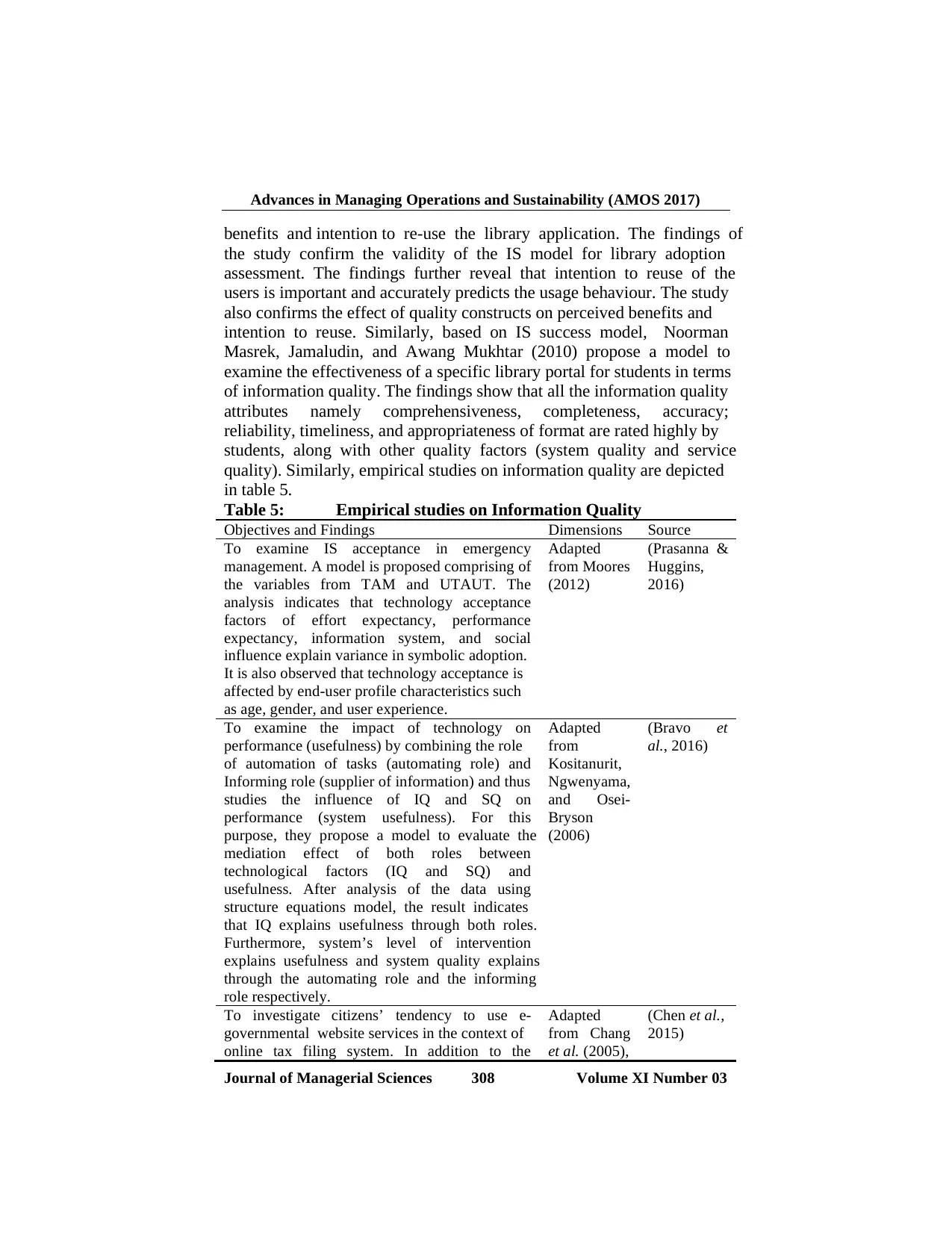
Advances in Managing Operations and Sustainability (AMOS 2017)
Journal of Managerial Sciences 308 Volume XI Number 03
benefits and intention to re-use the library application. The findings of
the study confirm the validity of the IS model for library adoption
assessment. The findings further reveal that intention to reuse of the
users is important and accurately predicts the usage behaviour. The study
also confirms the effect of quality constructs on perceived benefits and
intention to reuse. Similarly, based on IS success model, Noorman
Masrek, Jamaludin, and Awang Mukhtar (2010) propose a model to
examine the effectiveness of a specific library portal for students in terms
of information quality. The findings show that all the information quality
attributes namely comprehensiveness, completeness, accuracy;
reliability, timeliness, and appropriateness of format are rated highly by
students, along with other quality factors (system quality and service
quality). Similarly, empirical studies on information quality are depicted
in table 5.
Table 5: Empirical studies on Information Quality
Objectives and Findings Dimensions Source
To examine IS acceptance in emergency
management. A model is proposed comprising of
the variables from TAM and UTAUT. The
analysis indicates that technology acceptance
factors of effort expectancy, performance
expectancy, information system, and social
influence explain variance in symbolic adoption.
It is also observed that technology acceptance is
affected by end-user profile characteristics such
as age, gender, and user experience.
Adapted
from Moores
(2012)
(Prasanna &
Huggins,
2016)
To examine the impact of technology on
performance (usefulness) by combining the role
of automation of tasks (automating role) and
Informing role (supplier of information) and thus
studies the influence of IQ and SQ on
performance (system usefulness). For this
purpose, they propose a model to evaluate the
mediation effect of both roles between
technological factors (IQ and SQ) and
usefulness. After analysis of the data using
structure equations model, the result indicates
that IQ explains usefulness through both roles.
Furthermore, system’s level of intervention
explains usefulness and system quality explains
through the automating role and the informing
role respectively.
Adapted
from
Kositanurit,
Ngwenyama,
and Osei-
Bryson
(2006)
(Bravo et
al., 2016)
To investigate citizens’ tendency to use e-
governmental website services in the context of
online tax filing system. In addition to the
Adapted
from Chang
et al. (2005),
(Chen et al.,
2015)
Journal of Managerial Sciences 308 Volume XI Number 03
benefits and intention to re-use the library application. The findings of
the study confirm the validity of the IS model for library adoption
assessment. The findings further reveal that intention to reuse of the
users is important and accurately predicts the usage behaviour. The study
also confirms the effect of quality constructs on perceived benefits and
intention to reuse. Similarly, based on IS success model, Noorman
Masrek, Jamaludin, and Awang Mukhtar (2010) propose a model to
examine the effectiveness of a specific library portal for students in terms
of information quality. The findings show that all the information quality
attributes namely comprehensiveness, completeness, accuracy;
reliability, timeliness, and appropriateness of format are rated highly by
students, along with other quality factors (system quality and service
quality). Similarly, empirical studies on information quality are depicted
in table 5.
Table 5: Empirical studies on Information Quality
Objectives and Findings Dimensions Source
To examine IS acceptance in emergency
management. A model is proposed comprising of
the variables from TAM and UTAUT. The
analysis indicates that technology acceptance
factors of effort expectancy, performance
expectancy, information system, and social
influence explain variance in symbolic adoption.
It is also observed that technology acceptance is
affected by end-user profile characteristics such
as age, gender, and user experience.
Adapted
from Moores
(2012)
(Prasanna &
Huggins,
2016)
To examine the impact of technology on
performance (usefulness) by combining the role
of automation of tasks (automating role) and
Informing role (supplier of information) and thus
studies the influence of IQ and SQ on
performance (system usefulness). For this
purpose, they propose a model to evaluate the
mediation effect of both roles between
technological factors (IQ and SQ) and
usefulness. After analysis of the data using
structure equations model, the result indicates
that IQ explains usefulness through both roles.
Furthermore, system’s level of intervention
explains usefulness and system quality explains
through the automating role and the informing
role respectively.
Adapted
from
Kositanurit,
Ngwenyama,
and Osei-
Bryson
(2006)
(Bravo et
al., 2016)
To investigate citizens’ tendency to use e-
governmental website services in the context of
online tax filing system. In addition to the
Adapted
from Chang
et al. (2005),
(Chen et al.,
2015)
⊘ This is a preview!⊘
Do you want full access?
Subscribe today to unlock all pages.

Trusted by 1+ million students worldwide
1 out of 26
Your All-in-One AI-Powered Toolkit for Academic Success.
+13062052269
info@desklib.com
Available 24*7 on WhatsApp / Email
![[object Object]](/_next/static/media/star-bottom.7253800d.svg)
Unlock your academic potential
Copyright © 2020–2025 A2Z Services. All Rights Reserved. Developed and managed by ZUCOL.